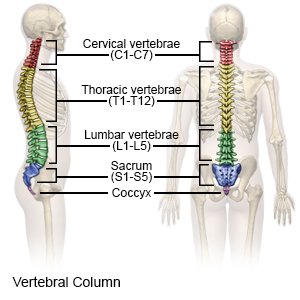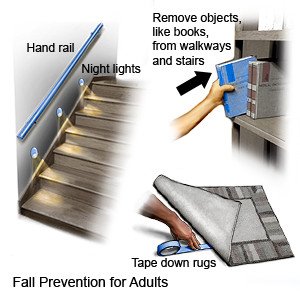Tethered Cord Syndrome
Medically reviewed by Drugs.com. Last updated on Aug 4, 2025.
What is tethered cord syndrome (TCS)?
TCS means your spinal cord is pulled down and tied (tethered) within your spinal column. The spinal cord normally moves freely within the spinal column. When it is tethered, it pulls during activity, causing pain and other problems.
 |
What are the signs and symptoms of TCS?
Any of the following may worsen as you get older, play sports, or during pregnancy:
- Pain in your back that goes to your legs, hips, or genital area or is worse when you move
- Trouble moving your legs or walking
- Numb or weak legs
- Trouble feeling something that touches your legs or feet
- Trouble controlling your bladder or bowels
What causes or increases my risk for TCS?
- A spinal problem you were born with, such as spina bifida
- A tumor or mass in your spine
- An infection
- Scar tissue from surgery or an injury that attaches to your spinal cord
How is TCS diagnosed?
Your healthcare provider will ask when your symptoms began and if they are getting worse. He or she may press or touch parts of your back. Tell him or her if you feel pain, or if an area is numb, tender, or tingling. Tell your provider about your medical history, including cancer, surgery, or injury in your spinal column. He or she may also use any of the following:
- Nerve tests help your healthcare provider check your muscle strength and ability to move.
- An MRI or CT scan may be used to check your spinal column. The pictures may show where your spinal cord is tethered. The pictures may also show a fatty mass or problem with how the bones in your spine are formed. Contrast liquid may be used to help your spinal cord show up better in the pictures. Do not enter the MRI room with anything metal. Metal can cause serious injury. Tell the provider if you have any metal in or on your body.
- A myelogram is an x-ray of your spinal column. Contrast liquid is used to show how well the liquid flows around the spinal cord and nerves.
- An ultrasound may be used to see the spinal cord as it moves in the spinal column.
How is TCS treated?
- Prescription pain medicine may be given. Ask your healthcare provider how to take this medicine safely. Some prescription pain medicines contain acetaminophen. Do not take other medicines that contain acetaminophen without talking to your healthcare provider. Too much acetaminophen may cause liver damage. Prescription pain medicine may cause constipation. Ask your healthcare provider how to prevent or treat constipation.
- Surgery may be used to free your spinal cord. This may help with your pain or other symptoms. Surgery may also make cysts smaller, and prevent more cysts from forming.
How can I manage TCS?
- Prevent falls. Move with care and stand up slowly. Wear shoes that support your feet, and do not go barefoot. Ask about walking aids, such as a cane or walker. You may want to install railings or nonslip pads in your home, especially in the bathroom. Ask for more information on how to prevent falls.

- Use the bathroom regularly if you have bladder or bowel control problems. Go to the bathroom at set times, such as every 2 hours, even if you do not feel the urge to go. Ask your healthcare provider how much liquid to drink each day and which liquids are best for you. You may need to limit the amount of liquid you drink to help control your urine leakage. Do not drink any liquid right before you go to bed. Limit or do not have drinks that contain caffeine or alcohol. Ask about the best foods to help you control bowel movements.
Call your local emergency number (911 in the US) if:
- You cannot move your legs.
When should I seek immediate care?
- You have severe pain.
- Your legs become so weak you cannot stand or walk.
When should I call my doctor?
- You have pain in between doses of your pain medicine.
- You have new or worsening symptoms.
- You have new or worsening trouble urinating or having a bowel movement.
- You have questions or concerns about your condition or care.
Care Agreement
You have the right to help plan your care. Learn about your health condition and how it may be treated. Discuss treatment options with your healthcare providers to decide what care you want to receive. You always have the right to refuse treatment. The above information is an educational aid only. It is not intended as medical advice for individual conditions or treatments. Talk to your doctor, nurse or pharmacist before following any medical regimen to see if it is safe and effective for you.© Copyright Merative 2025 Information is for End User's use only and may not be sold, redistributed or otherwise used for commercial purposes.
Further information
Always consult your healthcare provider to ensure the information displayed on this page applies to your personal circumstances.
